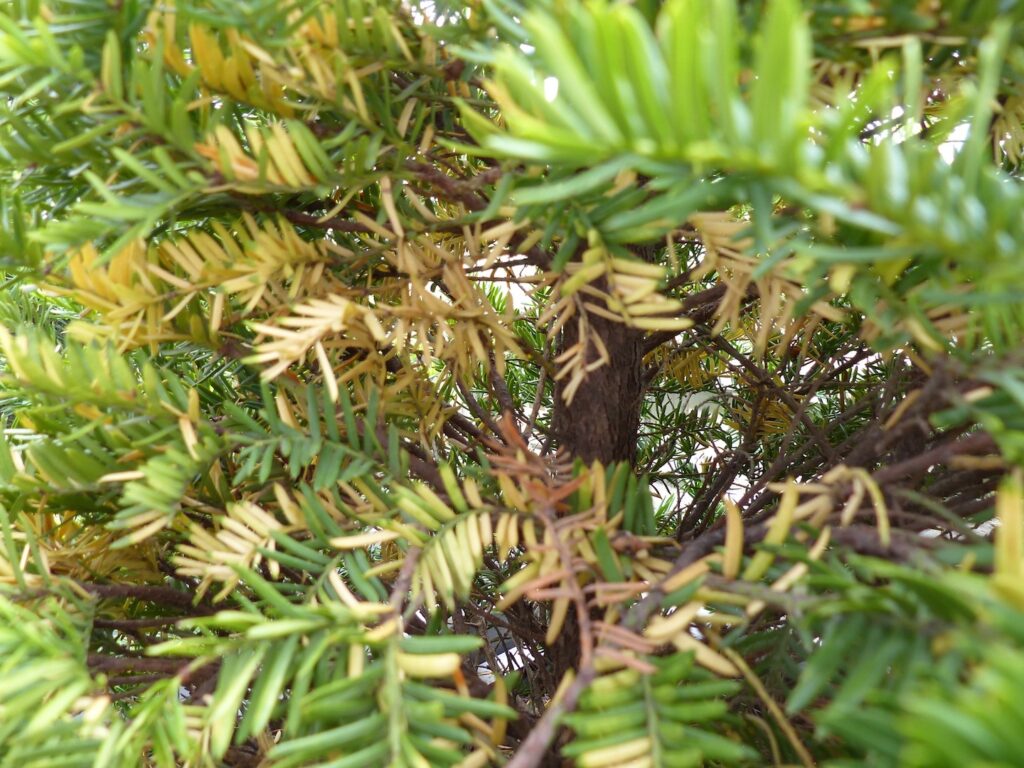
Hello Master Gardeners,
Last September we planted two 3 ft Taxus Capitata Clipped Yews on our west facing 6th floor balcony (with no overhang). They are in two 18″ x 18″ x 18″ insulated planters. We get full afternoon sun and occasional strong winds.
The yews looked great through the winter and until the beginning of June had deep green foliage. They are now both starting to get yellow needles on the inner parts of the tree. We put a 1/2 tree spike fertilizer in early April and have kept it regularly watered. We don’t believe we have overwatered.
Attached is a picture of what we are seeing. I’ve pulled the branches apart so you can see inside. We would appreciate any advice or comments. Thank you.
Yews are typically very hardy plants, and are not susceptible to many diseases. However, several stress factors can cause yews to turn brown.
Yews don’t like “wet feet” and can develop root problems if their roots are kept too wet. Although considered relatively drought-tolerant, too little water can also cause problems. So, making sure your containers have appropriate drainage holes for the yews and watering during very dry periods as well as in the winter is the best defense against these problems.
Trees and shrubs in containers will dry out far more quickly than those growing in the ground which is why watering correctly is the make-or-break of container gardening. Remember that the plant’s own foliage can prevent rain from reaching its soil, so don’t assume that if it has rained, your plants have been watered. Any added compost should be moist, but not sodden – even during winter when the wind can dry it out. From April to September, you should, ideally, check containers daily, especially during hot weather. Watering, whether with hose or can, should be done twice–fill the container to the brim and allow the water to filter down. Then repeat. This is the best way to ensure all of the compost has been wetted.
If the water is not draining freely, check the drainage holes and unblock as required. Mulching will help deter weeds and moss but will only have a minimal effect on water retention.
Winter damage also can affect yews. Winter injury occurs as a result of rapidly changing temperatures during the winter, bright sunshine, and inadequate water reserves in the root system of the plant. Plants usually show the first symptoms of winter injury in late winter through spring, and browning is most pronounced on the south and west sides of the plants. Although foliage turns brown, if buds remain green and viable, the plant may recover as the spring progresses. Yews affected by winter damage may recover over time, and it is wise to not prune out the brown tissue immediately in case the branch tips are still viable.
For added reassurance and insurance:
- Always choose frost-proof pots
- Protect them in winter by wrapping in bubble-wrap, sacking or a similar material
- Stand them on feet and remove saucers in winter. This will help protect against waterlogging – an equal, if not bigger, threat, than frost damage. (You can, of course, keep the feet in place throughout the year)
- Move them to a more sheltered spot for winter (If your containers are too large and therefore too heavy to move easily, make sure their location is not over-exposed)
- In dry periods during summer, check the compost regularly and water if dry.

